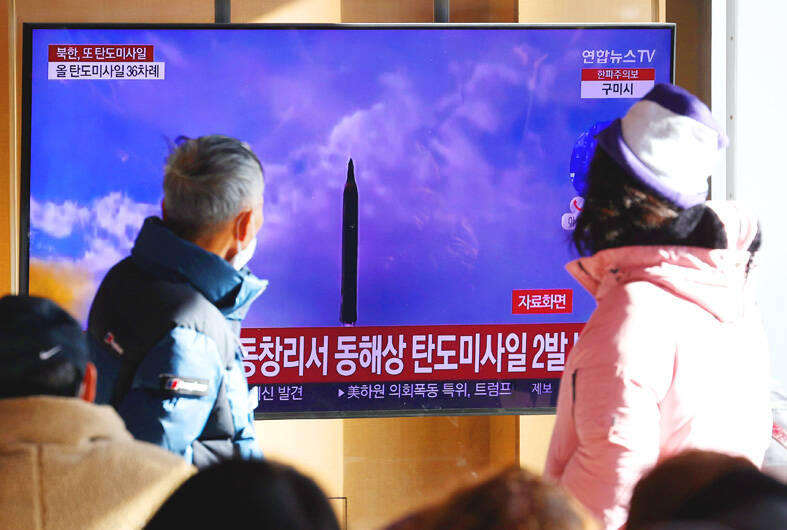North Korea yesterday test-fired a pair of nuclear-capable ballistic missiles with a range of striking Japan, in a possible protest of Tokyo’s adoption of a new security strategy to push for a more offensive footing against North Korea and China.
The launches also came two days after the North claimed to have performed a key test needed to build a more mobile, powerful intercontinental ballistic missile designed to strike the US mainland.
The two missiles traveled from the country’s northwest Tongchangri area about 500km at a maximum altitude of 550km before landing in waters between the Korean Peninsula and Japan, the South Korean and Japanese governments said.

Photo: EPA-EFE
South Korea’s military said both missiles were launched at a steep angle, suggesting the weapon could have traveled farther if fired at a standard trajectory.
North Korea usually tests medium and longer-range missiles at a high angle to avoid neighboring countries, although it fired an intermediate-range missile over Japan in October, forcing Tokyo to issue evacuation alerts and halt trains.
In an emergency meeting, top South Korean security officials decried North Korea’s continued provocations that they said came despite “the plight of its citizens moaning in hunger and cold due to a serious food shortage.”
They said South Korea would boost a trilateral security cooperation with the US and Japan, South Korea’s presidential office said.
Japanese Vice Minister of Defense Toshiro Ino separately criticized North Korea for threatening the safety of Japan, the region and the international community.
The US Indo-Pacific Command said the launches highlight the destabilizing impact of North Korea’s unlawful weapons of mass destruction and ballistic missile programs.
It said that US commitments to the defense of South Korea and Japan “remain ironclad.”
Kwon Yong-soo, a former professor at Korea National Defense University in South Korea, said North Korea likely tested its Pukguksong-2 missile, a solid-fueled, land-based variant of its Pukguksong family of missiles that can be fired from submarines.
Kwon said that flight details of the weapons tested yesterday were similar to those of the Pukguksong-2’s two known tests in 2017.
Kwon said the Pukguksong-2 can fly about 1,200km to 2,000km if it is launched at a normal trajectory, a range enough to strike key facilities in Japan, including US military installations.
“North Korea staged an armed protest with a land version of a submarine-launched ballistic missile that it can fire quickly in response” to the Japanese national security strategy, Kwon said.

The CIA has a message for Chinese government officials worried about their place in Chinese President Xi Jinping’s (習近平) government: Come work with us. The agency released two Mandarin-language videos on social media on Thursday inviting disgruntled officials to contact the CIA. The recruitment videos posted on YouTube and X racked up more than 5 million views combined in their first day. The outreach comes as CIA Director John Ratcliffe has vowed to boost the agency’s use of intelligence from human sources and its focus on China, which has recently targeted US officials with its own espionage operations. The videos are “aimed at

STEADFAST FRIEND: The bills encourage increased Taiwan-US engagement and address China’s distortion of UN Resolution 2758 to isolate Taiwan internationally The Presidential Office yesterday thanked the US House of Representatives for unanimously passing two Taiwan-related bills highlighting its solid support for Taiwan’s democracy and global participation, and for deepening bilateral relations. One of the bills, the Taiwan Assurance Implementation Act, requires the US Department of State to periodically review its guidelines for engagement with Taiwan, and report to the US Congress on the guidelines and plans to lift self-imposed limitations on US-Taiwan engagement. The other bill is the Taiwan International Solidarity Act, which clarifies that UN Resolution 2758 does not address the issue of the representation of Taiwan or its people in

US Indo-Pacific Commander Admiral Samuel Paparo on Friday expressed concern over the rate at which China is diversifying its military exercises, the Financial Times (FT) reported on Saturday. “The rates of change on the depth and breadth of their exercises is the one non-linear effect that I’ve seen in the last year that wakes me up at night or keeps me up at night,” Paparo was quoted by FT as saying while attending the annual Sedona Forum at the McCain Institute in Arizona. Paparo also expressed concern over the speed with which China was expanding its military. While the US

SHIFT: Taiwan’s better-than-expected first-quarter GDP and signs of weakness in the US have driven global capital back to emerging markets, the central bank head said The central bank yesterday blamed market speculation for the steep rise in the local currency, and urged exporters and financial institutions to stay calm and stop panic sell-offs to avoid hurting their own profitability. The nation’s top monetary policymaker said that it would step in, if necessary, to maintain order and stability in the foreign exchange market. The remarks came as the NT dollar yesterday closed up NT$0.919 to NT$30.145 against the US dollar in Taipei trading, after rising as high as NT$29.59 in intraday trading. The local currency has surged 5.85 percent against the greenback over the past two sessions, central